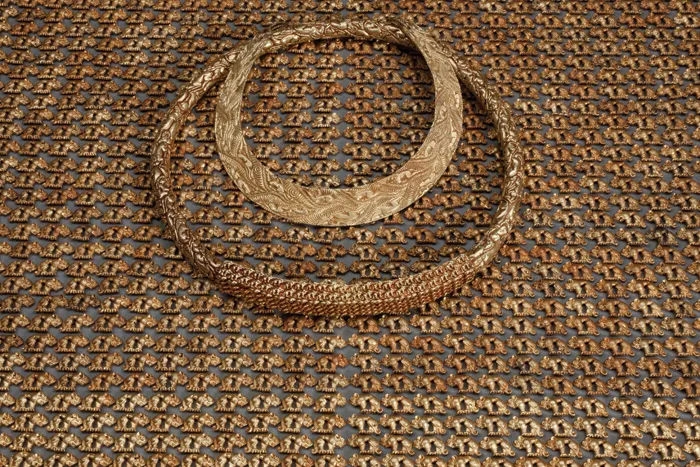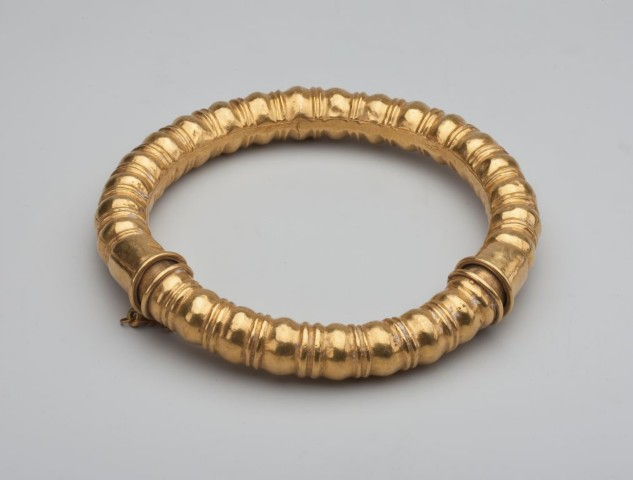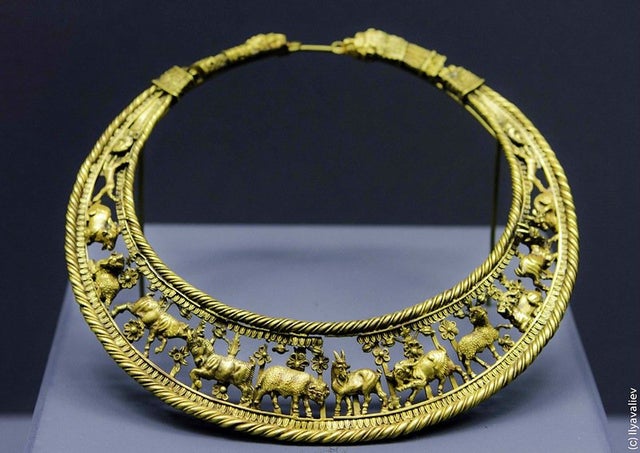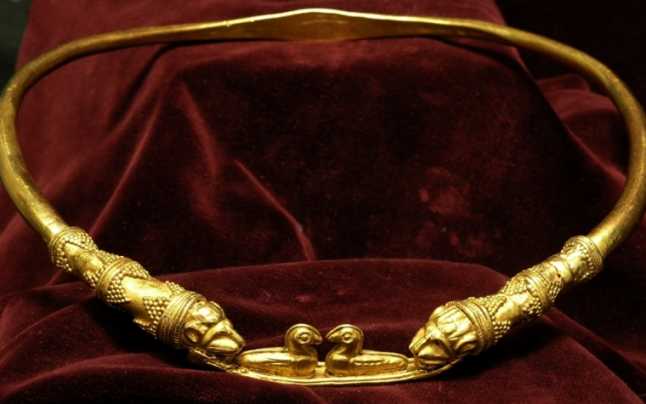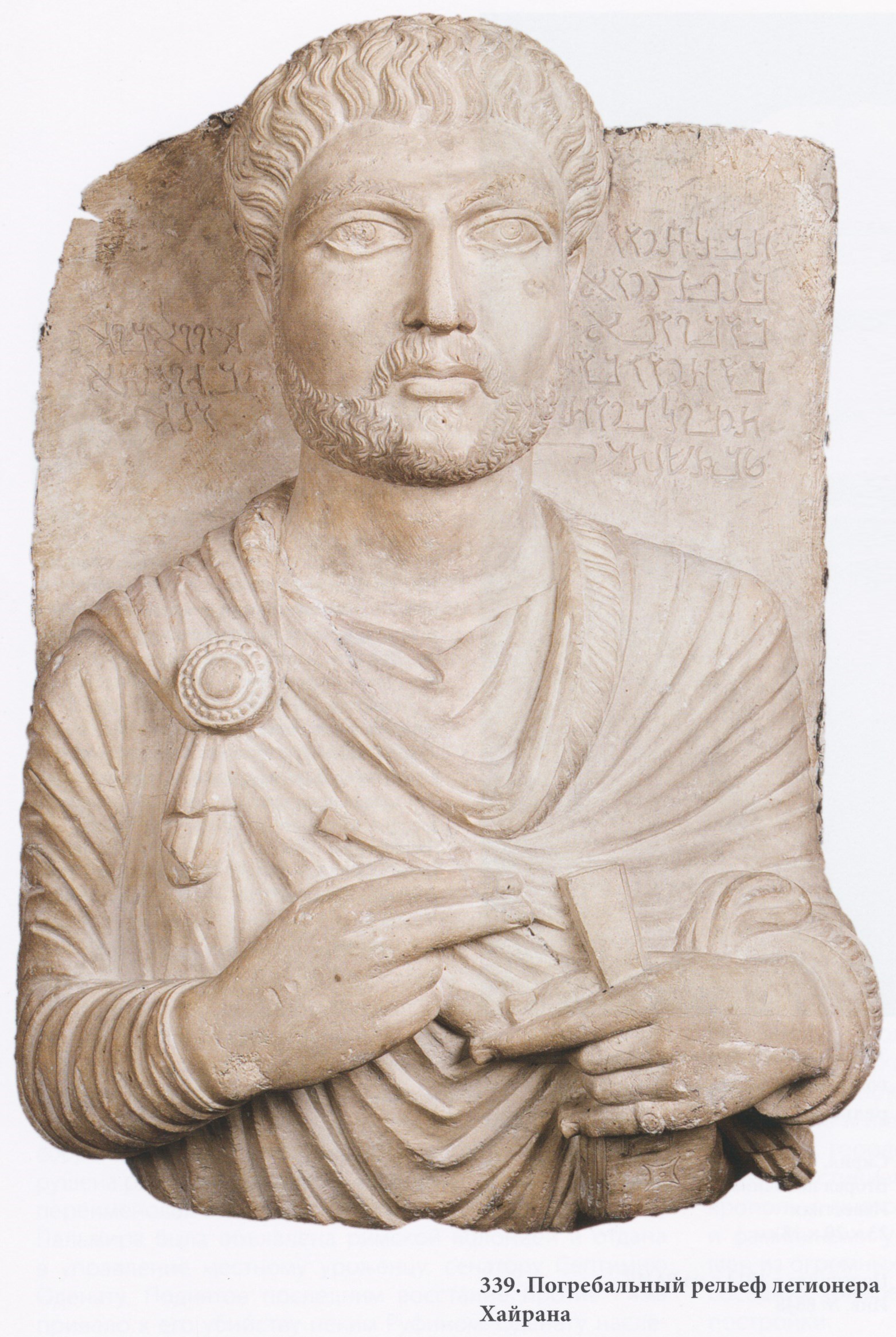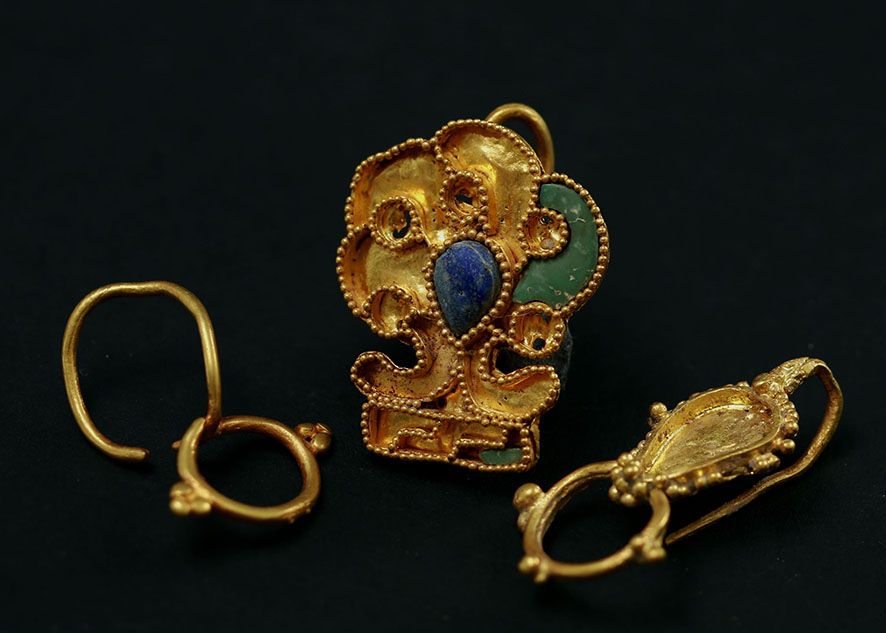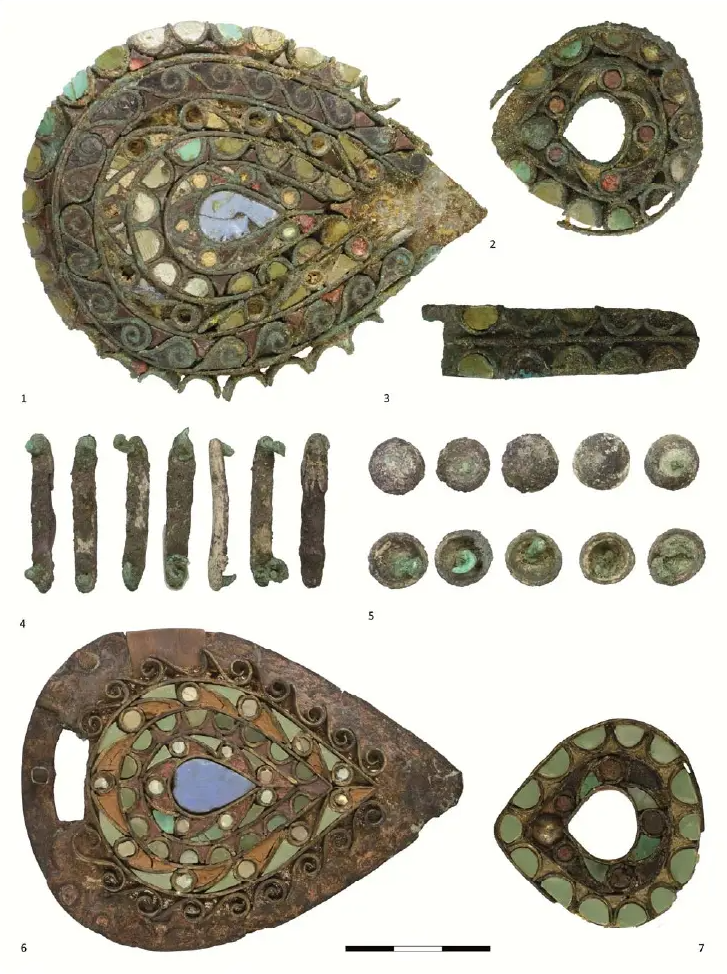Quotes from the article by Toshio Hayashi Xiongnu (Hun) Style Ornaments Found Near Turfan [with Google translation from Japanese]
“Chinese historical sources show that the Turfan oasis had been controlled or influenced by the Xiongnu Empire and sometimes by the Han Empire during the 2nd century BC – the 1st century AD. The gold items from the Gouxi cemetery show that the Turfan oasis had a close relation to the vast Eurasian steppe lands from the Xiongnu to the Sarmatian territories.”
“Yar Khoto is famous for the site of Tang Dynasty’s important hub city in the Western Region and then one of the capital cities of the Turfan Uyghur Kindom. But Turfan district has a previous longer history. In the Gouxi cemetery, southwestern plateau across a small river from Yar Khoto ruins, there are a lot of tombs of various periods. Most of tombs were robbed, but at last the joint team discovered undisturbed tombs and got several gold artifacts. Now I deal with them one by one and discuss their cultural relations.
The joint team discovered two undisturbed tombs: J VI-12, Tomb 1 and Tomb 16. From Tomb 1 pottery wear, gold torque, gold ornament incrusted with turquoise, gold finger ring, bronze mirror and shell ornament were unearthed.
a) Gold [hollow] torque (Figure 1).
Four-ply narrow tubes are curved but the rear part is lost (about 14 cm in diameter), found from Tomb 1. Extended animal motifs, tiger-like beast biting the buttock of a goat-like animal, are attached on upper and lower tubes.
Multi-tube torques with animal motifs are widely known in Saka tombs of Central Asia and in Sarmatian tombs of Northern Black Sea Region and Northern Caucasus. Now I will cite several instances.
In the famous Issyk kurgan near Almaty of Southern Kazakhstan [photos below], there is a gold of three- or four tubes with tiger heads attached on the upper and lower ends. It is 13 cm in diameter. The torque was discovered around the cervical vertebrae (neck bones) of the so-called “Golden Man”. The torque is consisted of two parts: front and back. The both ends of tubes of back part are a little narrower to insert into the tubes of front part. In the case of the Yar Khoto finding, the back part had been lost.
K. A. Akishev, the excavator of the Issyk kurgan, dated the kurgan to the 5th century BC, but his son A.K. Akishev dated it to the end of the 4th century BC-the beginning of the 3rd century BC. I agree with the son’s later dating, because the lion head representation is analogous to the lion of late Scythian art but a torque of multi-ply tubes was popular during the Sarmatian period as I will mention later. And the lions’ heads are located on the contrary positions of the right and left sides of neck, while in the case of Sarmatian torques animal motifs are located on the upper and the lower of the same positioned face. So I date this torque to the transitional time between the Scythian and the Sarmatian periods, the end of the 4th century BC – the beginning of the 3rd century BC.”

http://www.cunman.com/new/befaf443366a49fbb734e70f3a628e9c



https://vladimirdar.livejournal.com/60926.html
Six-tube hryvnia with heads of predators. Gold. 2nd-1st C BCE, Khutor Elitnyy, Krasnodar territory

https://vladimirdar.livejournal.com/60926.html
1st C BCE – 1st C CE, Krasnodar territory

[Atlas of Central Asian artistic crafts and trades. Kazakhstan]

https://www.hermitagemuseum.org

4th-2nd century BCE
https://www.hermitagemuseum.org/


From the Orenburg region, Russia. Found between village Chernoyarskaya and Korchazhinskaya, Kurgan 2
5th century BCE
16.8×2.1 cm

More >> http://colorsandstones.eu

Excavated from the south bank of Gongnaisi River in Xinyuan County, China.
Xinjiang Uyghur Autonomous Region Museum Collection
Photo Li Suya [after Wu Xin]
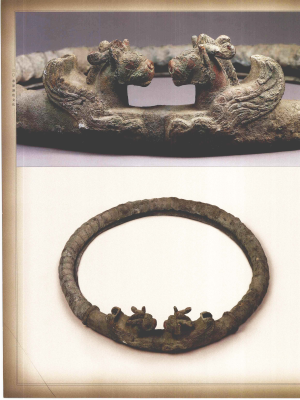
“There are at least four such objects found: two from Xinyuan in Xingjiang (Debaine-Francfort 1989, 199, pl. II/2; cf. Mu 1985, no. 92) and two from Almaty in Semirech’e. The two pieces from Semirech’e, one of which has a pair of winged goats crouching with their chests facing each other but the heads turned towards the front, the other is a large fragment of a ring. These two pieces are usually treated as fragments from one object, which is problematic based on the direction of the curves of the rings and the animal heads. It seems clear that the two fragments, in fact, belonged to two different specimens.” [Wu Xin]
“This artifact used by the ancient people of Xinjiang is a bit strange. On the circular hollow bronze tube, there is a pair of monsters staring at each other. The female form of the animal head should be that of a Xinjiang tiger, but it has curled and extended horns on its head, hair on its neck, wings spread out on both sides, and its body is bent backwards like a snake, forming a ring. This mysterious monster should be the god believed by the grassland people living in the Konaisi River Basin at that time. This artifact may be an artifact used in religious ceremonies at that time.”
Photo and info:
天山·古道·东西风:新疆丝绸之路文物特辑
Mountain Tianshan. Ancient Roads. The Meeting of East and West: The Extraordinary Cultural Relics from the Silk Road in Xinjiang, 中国社会科学出版社, 2002


Gold and turquoise.
Hermitage https://www.hermitagemuseum.org

Hryvnia from the burial of the Sarmatian queen from barrow No. 10 of the Kobyakovsky burial ground, the 1st – the beginning of the 2nd centuries. According to scientists she died at the age of 25-30 years.


Gold, turquoise, coral. Diam. 14,8 cm; H. 5,3 cm https://www.hermitagemuseum.org

Found: Pazyryk Barrow no. 2 (excavations by S.I. Rudenko). Altai Mountains, Pazyryk Boundary, the Valley of the River Bolshoy Ulagan
https://www.hermitagemuseum.org

This cast torque consists of two moving parts. The longer front part is decorated with two figures of tigers in relief, which are executed in the manner similar to the depictions of tigers on the objects found in the frozen barrows in the Altai Mountains.
https://www.hermitagemuseum.org

Iran, 5th-3th century BCE
Place of finding: Russia, Siberia
gold and turquoise, diam. 25 cm
https://www.hermitagemuseum.org

https://ru-sled.ru/vystavka-sokrovishha-donskix-stepej/
“This ring-shaped torc has overlapping ends each decorated with a depiction of a lion attacking a wild boar. Judging by the expressiveness of the subject and the masterful execution of the relief composition, this is one of the finest Helleno-Scythian torcs made for barbarians in the workshops of the Greek cities in the northern Black Sea region. This torc was the only jewellery of the warrior prince who was buried in the Karagodeuashkh tumulus.”
Scythian Culture. Second half of the 4th century BC
Found: Karagodeuashkh Tumulus. Krymskaya Cossack village, Kuban region, Russian Empire. Excavated by Yevgeny Felitsyn, 1888

http://colorsandstones.eu

http://colorsandstones.eu

https://www.hermitagemuseum.org

This torque is formed by a thick gold hoop with disconnected ends decorated with the heads of a feline beast of prey (lion or tiger). The animal’s ears and cheek-bones are inlayed with turquoise. Both in form and style the torque differs from those from Peter I’s Siberian Collection. It is attributed to the late Achaemenid art
https://www.hermitagemuseum.org

Found: Chertomlyk Tumulus. Dnieper Area, near Nikopol
https://www.hermitagemuseum.org

https://vladimirdar.livejournal.com/60926.html

https://www.hermitagemuseum.org

https://www.hermitagemuseum.org



FEMALE BURIAL Hryvna (torc, torque). Gold, turquoise, corals, glass. Diameter 17.8 cm. Height with frieze 6.3 cm. Khokhlach barrow, Rostov region, Novocherkassk. 1st century, Sarmatian. The Hermitage Museum Inv. No. GE 2213/1 (pictures and info – the Museum website https://vk.com)

Photo after Virgilio Hipolito-Correia
The early Iron Age transition in the goldwork of the west of The Iberian peninsula
Virgilio Hipolito-Correia
http://olharsobreadica.blogspot.com/2012/04/tesouro-da-adica-ou-tesouro-dos-alamos.html
http://maajournal.com/Issues/2017/Vol17-1/Rodriguez-Corral%2017%281%29.pdf
https://link.springer.com/content/pdf/10.1007/BF03214697.pdf


- Xiongnu (Hun) Style Ornaments Found Near Turfan; Toshio Hayashi
- М.И. Артамонов «Сокровища саков». Глава 6. Сибирское золото. Гривны и браслеты. https://ru-sled.ru/sibirskoe-zoloto-grivny-i-braslety/
- http://edu.hermitage.ru/catalogs/1418203874/themes/1418476253/article/1418492062
- Persian and Central Asian Contributions to the Formation of Social Landscape of the Early Nomads in Pazyryk, Southern Siberia; Wu Xin https://www.academia.edu
- Debaine-Francfort C., 1989, Archéologie du Xinjiang des origines aux Han. IIème partie https://www.persee.fr
https://www.academia.edu/resource/work/3875820
https://www.academia.edu/resource/work/63290715



